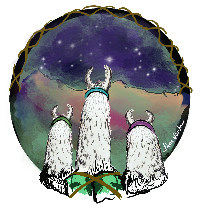When encountering large stock on the trail, always give them the right of way. Llamas rarely spook around horses, but many horses and mules can get upset. I try to get at least 100 feet off the trail, downhill if possible. Occasionally I might have to turn around in order to find a place to pass. It is much easier to turn Llamas around than horses and mules. Be especially cautious when encountering pack trains. A single outfitter with six or seven mules behind them needs a really wide berth. You do not want to be the one that starts a rodeo.

Loose Dogs- In the National Forest, dogs are allowed in wilderness areas. Usually within a half mile or so, most people let their dogs off leash. As soon as you see a dog up ahead, stop and engage the dog owner. Ask them to leash their dog and get at least thirty feet off the trail. Sometimes people will say their dogs are friendly. I respond that my llamas are afraid of strange dogs. My llamas are not afraid of new dogs, but they can get upset when the dog gives them the predator stare and they are too close to the trail.
Water crossings- When crossing water courses no one rule applies. Early summer high water crossings means that you must use caution. When the depth reaches a llamas belly and panniers that is when it becomes unsafe. Another problem is if there are round, slippery boulders. If your llama steps on these and stumbles, many times it will cause them to “bull rush” on across. Many times I have had to step aside and let the llamas go across by themselves, usually they will just stop on the other side and start eating grass. If there are two or more people, send one person holding long rope and then leading the llamas from the other side. Do not let your llamas stop in the water as this will cause them to pee and poop. I had a llama once that easily crossed a twenty or thirty foot wide stream but would leap ten feet when crossing a two foot wide run off.


![]()
